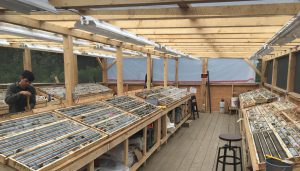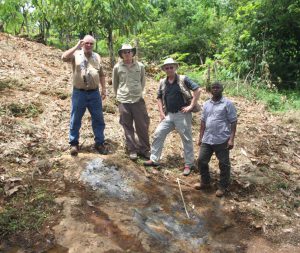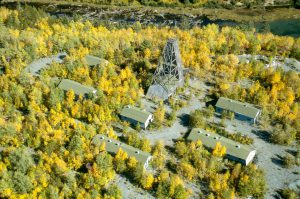Worldwide vehicle electrification to drive nickel demand

By Ellsworth Dickson
Nickel is a most useful base metal. Because rust never sleeps, some 75% of nickel produced is used to make stainless steel, most being what is known as Class 2 nickel. Class 1 nickel, or pure nickel, is used for making steel alloys, storage batteries for laptops and cell phones and, of increasing importance, electric vehicle (EV) batteries.
Nickel is part of the cathode in a Li-ion battery. It is these Li-ion batteries that are kick-starting a sea change in the nickel market.
Combining all uses, nickel demand grew 9.4% during 2018 and 2019 – outperforming all other major base metals – making it a US$20 billion per year industry. In 2018, Canadian exports of nickel-based products totaled $4.2 billion with Canada ranking fifth in the world for mine production.
Nickel prices are currently trading around US$14,000/tonne, or US$6.42/lb, up more than 30% from March lows and near its highest levels in November 2019.
And while stainless steel and other nickel usages continue to steadily grow as the world’s population increases, it is the EV market that is expected to see a huge growth in nickel demand, according to senior miner Glencore. For the first time, in 2017, sales of EVs passed the 1 million mark; however, this is just the beginning.
According to the International Energy Agency, (IEA), sales of electric cars topped 2.1 million globally in 2019, surpassing 2018 – already a another record year – to boost the stock to 7.2 million electric cars, 47% of which were in China. It’s hard to believe that in 2010, there were only 17,000 EVs on the road. Electric cars, which accounted for 2.6% of global car sales and about 1% of global car stock in 2019, registered a 40% year-on-year increase.
In their recent report, the IEA stated that nine countries had more than 100,000 electric cars on the road. At least 20 countries reached market shares above 1%. However, this growth has sometimes been disrupted by various events and circumstances that negatively affected EV sales.
Deloitte’s outlook shows EV sales reaching 21 million vehicles in 2030 as the cost of manufacturing batteries falls significantly and range anxiety becomes less of a concern. Another challenge for would-be EV buyers is availability of charging stations out of town and, in tow, lacking of charging stations in older apartment buildings.
This huge increase in EV sales will be even more jump-started with the introduction of electric pickup trucks, SUVs, delivery trucks and semi tractor trailers. This could cause a supply crunch for Class 1 nickel.
Interestingly, the IEA noted that electric two/three-wheelers will continue to represent the lion’s share of the total electric vehicle fleet, as this category is most suited to rapid transition to electric drive. The future electric two/three-wheeler fleet is concentrated in China, India and the ten countries of ASEAN.
Wood Mackenzie predicts an increase in nickel demand for EVs from 128 kt in 2019 to 265 kt in 2025 and 1.23 Mt in 2040, increasing nickel battery demand from 4% in 2018 to 31% by 2040.
It has been estimated that by 2025 the world need almost 1 million tonnes per year of new nickel supply. By 2030, 2.5 million tonnes, or double that of today, is required.
Wood Mackenzie is forecasting an average annual nickel deficit of 60,000 tonnes through to 2027 – a situation that bodes well for nickel explorers, developers and producers.
About one-half of the world’s nickel supply is suitable for use in batteries such as the nickel sulphide mines in Sudbury, Voisey’s Bay and Russia.
Those companies involved in discovering and mining nickel deposits are participating in a massive unstoppable global event with the electrification of the world’s vehicles – a good place to be.
 Garibaldi Resources Corp. [GGI-TSXV; GGIFF-OTC; RQM-FSE] has been following up its 2017 magmatic nickel massive sulphide discovery in the Golden Triangle region of northwestern British Columbia.
Garibaldi Resources Corp. [GGI-TSXV; GGIFF-OTC; RQM-FSE] has been following up its 2017 magmatic nickel massive sulphide discovery in the Golden Triangle region of northwestern British Columbia.
Located on Nickel Mountain, the flagship E&L deposit hosts nickel, copper, cobalt, platinum, palladium gold and silver. The latest drill results from the 2020 program have extended the strike length of the mineralized E&L system from 200 metres to over 650 metres to the east, where the intrusion remains open.
The 100%-owned project is the Golden Triangle’s first magmatic nickel-copper-rich massive sulphide system in the heart of the prolific Eskay Camp. The 2017 discovery drill hole EL-17-14 intersected 8.3% nickel, 4.2% copper, 0.19% cobalt, 1.96 g/t platinum, 4.5 g/t palladium, 1.1 g/t gold and 11.1 g/t silver over 16.75 metres starting 100.4 metres downhole, within a broader 40.4-metre core length highlighted by 3.9% nickel and 2.4% copper.
In February, 2019, Garibaldi confirmed an even shallower new zone (Northeast Zone) with drill hole EL-18-33 that returned 7.7% nickel and 2.95% copper over 4.8 metres within a broader interval of 49 metres grading 1.34% nickel and 0.89% copper (core length) plus cobalt, platinum, palladium, gold and silver credits.
Diamond drilling continues to build out on the persistent widespread nickel-copper mineralization, which includes massive sulphides featuring top-tier nickel-copper grades in addition to palladium, platinum, cobalt, gold, silver and strategic PGE (platinum group element) rare metals, including rhodium.
 Hole EL-20-88, collared 350 metres east of pivotal hole EL-19-80, intersected 142.79 metres of mineralized taxitic gabbro and olivine pyroxenite along trend of the E&L system. This large step-out hole exhibited an E&L geochemical signature which expanded the strike length of the E&L gabbroic intrusion to over 650 metres within a 2-km structural corridor that remains untested and open.
Hole EL-20-88, collared 350 metres east of pivotal hole EL-19-80, intersected 142.79 metres of mineralized taxitic gabbro and olivine pyroxenite along trend of the E&L system. This large step-out hole exhibited an E&L geochemical signature which expanded the strike length of the E&L gabbroic intrusion to over 650 metres within a 2-km structural corridor that remains untested and open.
Hole El-20-89 has produced the widest mineralized intercept so far from 71.34 metres to 223 metres returning nickel-copper mineralization over 151.6 metres grading 0.56% nickel and 0.61% copper. This intersect included 80.53 metres of 0.88% nickel and 0.85% copper, which expanded the northeastern massive sulphide zone six metres south, the LDZ 15 metres north and the Second Chamber 45 metres west.
Semi-massive veins along the contact edge with sediments assayed 0.33 metres (100.54 to 100.87 m) of 6.87% nickel and 1.69% copper, and 0.15 metres (147.48 to 147.63 m) of 3.04% nickel and 1.62% copper.
Garibaldi has drilled 10 additional holes at the E&L project on Nickel Mountain and is up to hole 94 so far this season. With new geochemical and geophysical targets located at depth, the immediate goal of the drill program is to follow the steeply-plunging E&L gabbro to the east. The conductors detected off hole will be drill tested for mineralization.
Garibaldi owns 100% of more than 200 km2 in Eskay Camp, including newly discovered high-grade gold quartz vein system at Casper, located 15 km north of Nickel Mountain. Assays are pending. The company also has four projects in Mexico.
Garibaldi’s nickel discovery is a unique development in the Golden Triangle with excellent potential for significant expansion at a time of increasing nickel demand from the electric vehicle market.
Just 12 km north of the E&L nickel deposit is Garibaldi’s 100%-owned Casper high-grade gold quartz vein discovery. The Casper gold vein is a strategic low elevation target (420 metres) within a km of road access and hydroelectric power.
Field crews collected 165 samples within 250 metres north of and 250 metres south of the northwest-southeast-striking Casper vein. High-grade grab samples at Casper were reported up to 249 g/t gold and assays for 86 Casper channel samples have been released with up to 92 g/t gold and 5.69 g/t gold over 52 metres.
Mechanical trenching at the Casper gold quartz vein has further uncovered the high-grade vein over more than 120 metres, from the initial 43 metres of hand trenching exposing the discovery.
The quartz vein remains open with mineralized rock samples extending along trend for 330 metres within a 500-metre gold-in-soil and MMI (mobile metal ion) geochemical anomaly.
The latest assays from 61 channel sample assays returned gold grades ranging from 0.676 g/t gold up to 93.29 g/t gold from a channel sample that contained visible gold.
The company has 116 million shares outstanding.
 Sama Resources Inc. [SME-TSXV; SAMMF-OTC.PK] is a Canada-based mineral exploration and development company with projects in West Africa, in particular, the Samapleu nickel-copper-cobalt-platinum group metals project in Côte d’Ivoire (Ivory Coast).
Sama Resources Inc. [SME-TSXV; SAMMF-OTC.PK] is a Canada-based mineral exploration and development company with projects in West Africa, in particular, the Samapleu nickel-copper-cobalt-platinum group metals project in Côte d’Ivoire (Ivory Coast).
Sama’s projects are located approximately 600 km northwest of Abidjan in Côte d’Ivoire and adjacent to the Guinean border in West Africa.
In 2010, Sama discovered nickel-copper-PGE mineralization, including veins and lenses of high grades material near surface at numerous locations within the then discovered Yacouba intrusive complex.
In October, 2017, Sama announced that it had entered into a binding term sheet in view of forming a strategic partnership with HPX TechCo Inc., a private mineral exploration company in which mining entrepreneur Robert Friedland is a significant stakeholder, in order to develop the Samapleu Project. HPX is spending $18 million on the project.
 Since March 2010, Sama has performed surface IP and Mag surveys as well as Airborne Mag-Radiometric and HTEM surveys and 388 boreholes for a total of 54,000 metres of drilling. Mineral resources assessments have been completed at one site, the Samapleu deposit, aiming for a modest scale Ni-Cu open pit mining and processing operation, while continuing to explore newly discovered prospective ground. Sama’s objective is to delineate massive sulphide reservoirs that could be the source of these high-grade nickel-copper-cobalt-palladium lenses. The newly discovered Yacouba complex can be compared to other world class bases metals camps like Jinchuan in China and Voisey’s Bay in Canada, etc.
Since March 2010, Sama has performed surface IP and Mag surveys as well as Airborne Mag-Radiometric and HTEM surveys and 388 boreholes for a total of 54,000 metres of drilling. Mineral resources assessments have been completed at one site, the Samapleu deposit, aiming for a modest scale Ni-Cu open pit mining and processing operation, while continuing to explore newly discovered prospective ground. Sama’s objective is to delineate massive sulphide reservoirs that could be the source of these high-grade nickel-copper-cobalt-palladium lenses. The newly discovered Yacouba complex can be compared to other world class bases metals camps like Jinchuan in China and Voisey’s Bay in Canada, etc.
Highlights of a Preliminary Economic Assessment at Samapleu, include average annual production of 3,900 tonnes of carbonyl nickel powder, 8,400 tonnes of carbonyl iron powder and 14,100 tonnes of copper concentrate over a 20-year mine life. Capital costs are estimated to be $282 million, including a contingency of $37 million with operational costs of $23.96/tonne milled.
Pre-tax Net Present Value (8% discount rate) is $615 million and an Internal Rate of Return of 32.5%. After-tax NPV (8% discount rate) of $391 million and an after-tax IRR of 27.2%.
Geophysical activities have resumed with downhole electromagnetic surveys planned in four deep drill holes at the Yepleu target zone and in one deep drill hole at the Bounta target zone. The holes at Yepleu and Bounta were drilled in the early months of 2020, with both zones part of the large Yacouba Ultramafic-Mafic intrusive complex discovered by Sama in 2010.
Future production will be managed by a JV controlled 66⅔% by Sama Nickel Corp. a wholly-owned subsidiary of Sama Resources, and 33⅓% by SODEMI. Sama Resources has $2.5 million in its treasury and holds $12.4 million in securities with no debt. The company has 216,466,410 shares outstanding.
The Samapleu nickel-copper-cobalt-platinum group metals project is located in mining-friendly West Africa, home to a number of successful mining operations. The polymetallic project hosts a suite of metals – nickel-copper-cobalt-platinum group metals – all of which are currently in demand.
 Tartisan Nickel Corp. [TN-CSE; TTSRF-OTC; A2D-FSE] has favourably positioned itself to participate in the growing electric vehicle sector with its advanced-stage Kenbridge nickel-copper-cobalt project in northwestern Ontario.
Tartisan Nickel Corp. [TN-CSE; TTSRF-OTC; A2D-FSE] has favourably positioned itself to participate in the growing electric vehicle sector with its advanced-stage Kenbridge nickel-copper-cobalt project in northwestern Ontario.
While copper and cobalt are important for the EV battery and vehicle market, Elon Musk of Tesla Motors recently stated that nickel remains a key ingredient to its rapidly improving EV battery technology. Stainless steel production still accounts for the majority of nickel usage; however, commodity research firm Roskill has stated that the current EV nickel demand will grow from 4% to 15-20% of the market.
Longer term, California Governor Gavin Newsom just signed an executive order that will ban the sale of new gas-powered passengers cars starting in 2025.
Tartisan’s Kenbridge Project, located near Atikwa Lake in the Kenora-Fort Frances area, has undergone an updated mineral resource estimate.
The updated estimates were done for pit constrained and out-of-pit nickel, copper, and cobalt resources. Total Measured & Indicated Mineral Resources, based on a Net Smelter Return (NSR) cut-off value of CDN$15/tonne for pit constrained Mineral Resources and CDN$6/tonne NSR for out-of-pit Mineral Resources is 7.5 Mt at 0.58% nickel and 0.32% copper for a total of 95 Mlb of contained nickel. An additional 0.985 Mt at 1.0% nickel and 0.62% copper (22 Mlb contained nickel) were calculated as Inferred Resources. Pit constrained Measured & Indicated Resources total 5.27 Mt of 0.45% nickel, 0.26% copper and 0.009% cobalt at an NSR cut-off value of CDN$15/tonne. The out-of-pit Measured & Indicated Resources total 2.23 Mt of 0.86% nickel; 0.45% copper; and 0.006% cobalt. Inferred Mineral Resources out-of-pit total 0.985 Mt at 1.00% nickel, 0.62% copper and 0.003% cobalt, at an NSR cut-off value of CDN$60/tonne.
Mark Appleby, President and CEO, notes that the deposit is open to depth with the highest nickel grades having a strong down-plunge orientation such as hole KB07-180 that returned 2.95% nickel and 0.82% copper over 21.5 metres, including 7.2% nickel and 0.67% copper over 5.5 metres.
Highlights of an Updated PEA were: average nickel recovery life-of-mine was 86%; recovered nickel was 84.6 Mlb; NPV7.5% pre-tax was $253M; and IRR% pre-tax was 65%.
 The Kenbridge property has good access to roads and power. It has a shaft to a depth of 622 metres, with level stations at 45-metre intervals below the shaft collar and two levels developed at 107 metres and 152 metres below the shaft collar.
The Kenbridge property has good access to roads and power. It has a shaft to a depth of 622 metres, with level stations at 45-metre intervals below the shaft collar and two levels developed at 107 metres and 152 metres below the shaft collar.
Tartisan Nickel has planned a surface exploration and definition drilling plan, in addition to geotechnical, metallurgical and environmental work to advance the project in the upcoming 2020 winter season and into summer 2021.
The company also owns equity stakes in Eloro Resources Ltd. that is exploring the 99%-optioned ISKA ISKA Project, a gold-silver-zinc-lead target with a 3,500-metre underground drilling program underway in the Potosi district, Bolivia, and the low-sulphidation epithermal 82%-owned La Victoria gold-silver project in Peru.
Tartisan is a shareholder in Class 1 Nickel and Technologies that holds the past-producing Alexo-Kelex Dundonald nickel project near Timmins, Ontario in which Tartisan has a 0.5% NSR. The property hosts an estimated total NI 43-101 compliant Indicated Mineral Resources of 571.7k tonnes averaging 0.77% nickel plus Inferred Resources.
Being a prospect generator, Tartisan spun out the Alexco-Kelex Project to Class 1 Nickel as well as the La Victoria Project to Eloro.
Tartisan is a shareholder in Peruvian Metals Corp. that is operating a toll mill in Peru and announced an exploration and bulk sampling program on the high-grade gold-silver-copper Palta Dorada Project.
Tartisan also has a 100% interest in the Sill Lake silver-lead project near Sault Ste. Marie, Ontario.
Tartisan’s investment portfolio is in excess of $7 million which can provide funds for its activities and avoids share dilution through further share issuances. The company has 101.6 million shares outstanding.
Though its acquisitions and investments, Tartisan Nickel is poised to benefit from the burgeoning EV battery sector as well as its precious metal and base metal prospects.
